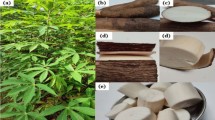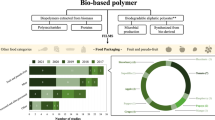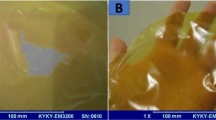Abstract
Novel biomaterials and optimal processing conditions are fundamental in low-cost packaging material production. Recently, a novel biobased intact bitter cassava derivative was developed using an intrinsic, high-throughput downstream processing methodology (simultaneous release recovery cyanogenesis). Processing of intact bitter cassava can minimise waste and produce low-cost added value biopolymer packaging films. The objective of this study was to (i) develop and characterise intact bitter cassava biobased films and (ii) determine the optimal processing conditions, which define the most desirable film properties. Films were developed following a Box-Behnken design considering cassava (2, 3, 4 % w/v), glycerol (20, 30, 40 % w/w) and drying temperature (30, 40, 50 °C) and optimised using multi-response desirability. Processing conditions produced films with highly significant (p < 0.05) differences. Developed models predicted impact of processing conditions on film properties. Desirable film properties for food packaging were produced using the optimised processing conditions, 2 % w/v cassava, 40.0 % w/w glycerol and 50 °C drying temperature. These processing conditions produced films with 0.3 %; transparency, 3.4 %; solubility, 21.8 %; water-vapour-permeability, 4.2 gmm/m2/day/kPa; glass transition, 56 °C; melting temperature, 212.6 °C; tensile strength, 16.3 MPa; elongation, 133.3 %; elastic modulus, 5.1 MPa and puncture resistance, 57.9 J, which are adequate for packaging applications. Therefore, intact bitter cassava is a viable material to produce packaging films that can be tailored for specific sustainable, low-cost applications.




Similar content being viewed by others
References
Arismendi, C., Chillo, S., Conte, A., Del Nobile, M. A., Flores, S., & Gerschenson, L. N. (2013). Optimization of physical properties of xanthan gum/tapioca starch edible matrices containing potassium sorbate and evaluation of its antimicrobial effectiveness. LWT - Food Science and Technology, 53, 290–296.
ASTM 882-09. (2009). Standard test method for tensile properties of thin plastic sheeting. West Conshohocken: American Society for Testing and Materials.
Belibi, P. C., Daou, T. J., Ndjaka, J. M. B., Nsom, B., Michelin, L., & Durand, B. (2014). A comparative study of some properties of cassava and tree cassava starch films. Physics Procedia, 55, 220–226.
Burns, A., Gleadow, R., Cliff, J., Zacarias, A., & Cavagnaro, T. (2010). Cassava: the drought, war and famine crop in a changing world. Sustainability, 2, 3572–3607.
Cerqueira, M. A., Sousa-Gallagher, M. J., Macedo, I., Rodriguez-Aguilera, R., Souza, B. W. S., Teixeira, J. A., & Vicente, A. A. (2010). Use of galactomannan edible coating application and storage temperature for prolonging shelf-life of “Regional” cheese. Journal of Food Engineering, 97, 87–94.
Chiwona-Karltun, L., Mkumbira, J., Saka, J., Bovin, M., Mahungu, N., & Rosling, R. (1998). The importance of being bitter—a qualitative study on cassava cultivar preference in Malawi. Ecology of Food and Nutrition, 37, 219–245.
de Moraes, J. O., Scheibe, A. N., Sereno, A., & Laurindo, J. B. (2013). Scale-up of the production of cassava starch based films using tape-casting. Journal of Food Engineering, 119, 800–808.
Derringer, G., & Suich, R. (1980). Simultaneous optimization of several response variables. Journal of Quality Technology, 12, 214–219.
Embuscado, M. E., & Huber, K. C. (2012). Edible films and coatings for food application. New York: Springer. 410pp.
Essers, A. (1988). Bitter cassava as a drought resistant crop. A case in Mozambique. ILElA- ILEIA, The Centre for Learning on Sustainable Agriculture Newsletter, 1.4(4), 1–2.
Flores, S. K., Costa, D., Yamashita, F., Gerschenson, L. N., & Grossmann, M. V. (2010). Mixture design for evaluation of potassium sorbate and xanthan gum effect on properties of tapioca starch films obtained by extrusion. Materials Science and Engineering, 30, 196–202.
Line, C. (2006). Cassava roots source of tapioca. Ohio State University Extension and the Ohio Agricultural Research and Development Centre. http://www.oardc.ohio-state.edu
Maran, J. P., Sivakumar, V., Sridhar, R., & Thirugnanasambandham, K. (2013a). Development of model for barrier and optical properties of tapioca starch based edible films. Carbohydrate Polymers, 92, 1335–1347.
Maran, J. P., Sivakumar, V., Thirugnanasambandham, K., & Sridhar, R. (2013b). Response surface modelling and analysis of barrier and optical properties of maize starch edible films. Carbohydrate Polymers, 92, 1335–1347.
Muo, C., Guo, J., Li, X., Lin, W., & Li, D. (2012). Preparation and properties of dialdehyde carboxymethylcellulose cross-linked gelatin edible films. Food Hydrocolloids, 27, 22–29.
Olivato, J. B., Grossmann, M. V. E., Bilck, A. P., & Yamashita, F. (2013). Starch/polyester films: simultaneous optimisation of the properties for the production of biodegradable plastic bags. Polímeros, 23, 32–36.
Pelissari, F. M., Andrade-Mahecha, M. M., do Amaral Sobral, P. J., & Menegalli, F. C. (2013). Optimization of process conditions for the production of films based on the flour from plantain bananas (Musa paradisiaca). LWT - Food Science and Technology, 52, 1–11.
Souza, V. C., Monte, M. L., & Pinto, L. A. A. (2011). Preparation of biopolymer film from chitosan modified with lipid fraction. International Journal of Food Science and Technology, 46, 1856–1862.
Souza, A. C., Benze, R., Ferrão, E. S., Ditchfield, C., Coelho, A. C. V., & Tadini, C. C. (2012). Cassava starch biodegradable films: influence of glycerol and clay nanoparticles content on tensile and barrier properties and glass transition temperature. LWT - Food Science and Technology, 46, 110–117.
Steele, T. W. J., Huang, C. L., Kumar, S., Irvine, S., Chiang Boey, F. Y., Loo, J. S. C., & Venkatraman, S. S. (2012). Novel gradient casting method provides high-throughput assessment of blended polyester poly(lactic-co-glycolic acid) thin films for parameter optimization. Acta Biomaterials, 8, 2263–2270.
Tapia-Blácido, D. R., do Amaral Sobral, P. J., & Menegalli, F. C. (2011). Optimization of amaranth flour films plasticized with glycerol and sorbitol by multi-response analysis. LWT - Food Science and Technology, 44, 1731–1738.
The, D. P., Debeaufort, F., Voilley, A., & Luu, D. (2009). Influence of hydrocolloid nature on the structure and functional properties of emulsified edible films. Food Hydrocolloids, 23, 691–699.
Tumwesigye, S. K., Oliveira, J. C. & Sousa-Gallagher, M. J. (2014). Intact bitter cassava processing can reduce waste andproduce biopolymer packaging material. Oral Presentation at the International Congress “Advances in Food Processing”, Royal Palm Plaza Campinas, Sao Paulo, Brazil, 5 - 7th November.
Tumwesigye, K. S., Oliveira, J. C., Sousa Gallagher, M. J. (2015). New sustainable approach to reduce Cassava borne environmental waste and develop biodegradable materials for food packaging applications, Food. Pack. Shelf. (in press).
Vuong, T. T. P., Chiwona–Karltun, L. & Ntawuruhunga, P. (2012). Farmers’ perceptions of the “Unleashing the Power of Cassava in Africa in Response to the Food Crisis”. Master thesis in Sustainable Development. Uppsala Universitet. pp. 56.
Acknowledgments
This research has been funded by the National Agricultural Research Organisation (NARO), under the Ministry of Agriculture Animal Industry and Fisheries (MAAIF), through the East African Agricultural Productivity Program (EAAP), by the World Bank.
Author information
Authors and Affiliations
Corresponding author
Rights and permissions
About this article
Cite this article
Tumwesigye, S.K., Montañez, J.C., Oliveira, J.C. et al. Novel Intact Bitter Cassava: Sustainable Development and Desirability Optimisation of Packaging Films. Food Bioprocess Technol 9, 801–812 (2016). https://doi.org/10.1007/s11947-015-1665-y
Received:
Accepted:
Published:
Issue Date:
DOI: https://doi.org/10.1007/s11947-015-1665-y




